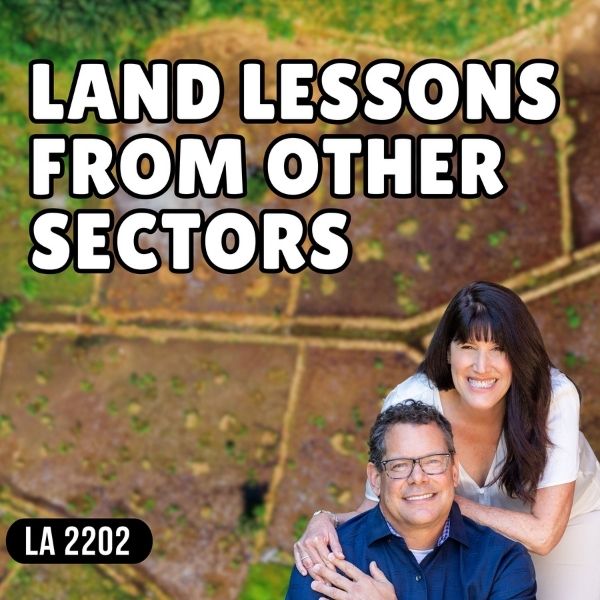This is episode number 2202. Jill and I are talking about land investing lessons that we’ve learned from other real estate sectors. Really, what we’re talking about is the relationship between commercial real estate and the economy and the effect that it may or may not have on residential real estate. We’re always looking to try to look into a crystal ball to find out what’s going to happen in the future with real estate. It’s the exact opposite, or so the SEC says, when you’re trading stock. You’d never want to know what’s going to happen. They want you to speculate. In the real estate industry, we’re all encouraging you to get inside information and make decisions on that and make your bank bigger.
That’s nothing to do with the notes that I wrote down.
Do you think this is an opposite attracts situation with you and I or do you think it’s just that you feel sorry for me?
You put a topic in front of me, I wrote down what came to my mind, but you had a different vision. If it’s okay with you, when we get to the topic, I’ll get mine out of the way, my couple of comments, and then I’ll let you explain where you were going.
Sounds good. Each day on the show, we answer a question from our Land Academy Member Discord Forum and take a deep dive in land-related topics.
Could you imagine if mine were all like, “Cookies in the oven are great for staging.” It’s not that.
That’s when this whole show would’ve ended on episode five.
Mailing Lists & Filtering Properties
For me, too. Okay, so here’s our question. Tara wrote, “Hello everyone.” Tara’s doing some big mail right now. “Quick question. I’m working on a mailer and I’ve exported leads into a target zip code. When I’m doing my test, I noticed two things. I pulled a lot of properties with structures on them, despite my efforts to exclude them and hundreds, if not more, properties owned by corporations, i.e., municipalities, local companies, and LLCs.” I love those. “I know the more mail we send, the better, but should I be trying to remove these properties or is it just part of when we cast a wide net? Any insight would be much appreciated. Thank you.”
I love both of them. If there’s a structure that’s snuck in there, awesome. A little bit of an improvement thing, let’s see what comes back. If you price it without that and they call you, it could be a home run. That’s great. LLCs, I know many companies, including my own, that buy and sell land in LLCs. You don’t want to take that stuff out. What do you want to add?
There’s a theme in our land and house investment operation. It’s evidenced by Jill’s answer. I completely agree with Jill. We are carpet bombers. We are not afraid of mail expense. The more mail expense that we have, $20,000, $30,000, $40,000, $50,000 a month, the happier we both are because we know what’s going to happen because we’ve done it a million times.
There are a lot of people, especially at the beginning of your career, who are conscious about mail. I’m not saying you’re one of these people, Tara, I’m saying this is just common sense. “I only want to spend $13 on mail, let’s say, and I want to do a deal. That’s very unrealistic.” It’s like pulling the handle on a slot machine and winning the first time.
Also, like a first marriage.
Yes, just like that.
I’m just kidding. Sorry.
I recommend it in Land Academy 3.0. I think it’s chapter 4, possibly 3. You should not be downloading leads from zip codes, by the way. You should be doing it from the county. You’re going to miss a lot of properties because many of them don’t have a zip code assigned to the piece of property, because it’s vacant land.
The post office only assigns an address or a zip code upon request. They don’t run around and do it for all pieces of land. What I would highly recommend and I do in 3.0, is that you’ve got 2 or 3 zip codes in a county. Congratulations. You did everything right so far. Download the entire county because data is cheap, but mail is expensive. You want to download that data and have it be satisfactory to you.
This is where I’m answering the question. You don’t like those companies in there, I understand that, then maybe the download that you did or this county or these zip codes, turns out that they’re not what you want anyway. If you don’t follow what I say in chapters 3 and 4 of Land Academy 3.0, you’ll get a lot of structures in there and that could be for 1 or 2 reasons. You didn’t follow the directions or it’s so rural that assessors don’t really care if there’s a structure on there. There are a lot of places in Arkansas and South Dakota like that, specifically, but Jill’s right. Awesome. Let it rip. Our motto is let it rip. Let’s see what comes back. We’ll buy a couple of properties no matter what.
See who calls you. That’s the whole point.
This episode’s topic, land investing lessons from the other side from the other real estate sectors.
Lessons From Other Real Estate Sectors
I was just thinking of big picture, some lessons that I’ve learned from others, which is good. It’s still going to be beneficial for our topic. One of them is for those people flipping SFRs, I’m pretty sure if this is your world. You don’t want to hold these too long. You need to get them sold or rented because those carrying costs will kill you even if you pay cash for it. Most SFR people, I don’t think they do pay cash. I think they still run around taking out loans, thinking, “I got this. I have 30 days saved up for it,” whatever it is. “Once I rent it out or once I sell it, it’s going to push me forward into the next one.” That’s my lesson number one.
Number two, for people doing commercial properties, and we’ve done all these things too, so I’m not just talking about my peers, I’m talking about things that we’ve learned, which is part of it here. With commercial properties, my point number two is you’ve got to really make sure that you’re buying and building properties that are in an area that’s up and coming. I hate the word path of growth, but they always use the path of growth term. It’s almost like BRRR. It’s one of those terms that they throw around, but path of growth is their term.
The point is if you’re going to buy a perfect piece of land, like, “This is great for a McDonald’s,” and there’s nothing out there, that doesn’t make sense. If you’re going to be flipping land, there’s a McDonald’s and a Dunkin’ Donuts and here comes Chick-fil-A and you’ve got the lot next door, good for you and there’s a community college right there, that all makes sense. They’re new and upcoming, so you can see it.
Number three, lessons from other sectors, other real estate sectors, the office space people. I wouldn’t want to be in their shoes. I feel bad for them. They went crazy. I think for a lot of cities, they went bananas and they overbuilt and now they’re trying to pivot and figure out what to do with them. I just wrote it off as yikes. What’s your whole take on all this? Where did you see this whole thing going now?
It was an economic relationship between houses and commercial real estate. Here’s an example. They coexist. An Amazon facility might go into an urban area like, I don’t know, Mesa, Arizona. What will follow is a positive economic impact on housing.
Also, because of the jobs.
All of that. You can predict that. If you can predict it when the announcement goes in and when the construction’s happening, you can get in on some very profitable real estate situations. Just rental houses because people are going to work, bring in jobs. The reverse is true. When there are a lot of residents, large companies, a classic example is the high-growth Tesla moved into and incorporated their own town in Texas. The impact on housing was going to be dramatic.
I guess that’s the Amazon example. Specifically Tesla, they went into certain areas of Texas where they knew that there was going to be tech talent and the type of labor that they needed. Whatever happens with commercial or residential, the other seems to follow and they coexist. The key is, for me, how can I make money on that? How can I make really serious, not even predictions, but like, “This is probably going to happen now?”
You need to look at both of those things and it’s beyond the scope of a 15 or 13-minute episode, but just please be aware of it. The other way, too, and we haven’t mentioned it, is that it gets very complicated is when we talk about economic factors. Is there growth in the housing industry? Are housing prices going down or up? Are office building vacancies going down or up?
Construction costs.
The Economic Interplay Between Commercial & Residential Real Estate
Yeah. Those things affect each other. This is the whole takeaway. In general, when commercial real estate gets hit economically, and it is right now, vacancy rates go up, construction goes down or distribution or whatever ends up being in your little local market that you’re looking at, it affects housing about a year later.
That’s happening right now. A year ago, commercial real estate was getting pounded. There are a lot of things that affect both of them, regardless of product type. Interest rates, economic conditions, and unemployment rates. It’s very wise to keep your pulse on if you’re going to be in this industry or you are in this industry on what’s happening with commercial real estate. It will affect land and houses about a year later. Join us next time. We’re going to talk about how to deal with jealous friends when you’re winning. You are not alone in your real estate ambition. We are Jack and Jill. Information and inspiration to buy undervalued property.















